Posted: June 10th, 2014 | No Comments »
And just to finish up on old Yokohama….Although a treaty port, Yokohama never quite took on the international characteristics of a Shanghai, but it didn’t do bad and parts of its were indeed as “bad” as Shanghai at its height in the late nineteenth and early twentieth century….

The Yokohama Bund

A Yokohama chemist’s shop

The Yokohama Custom’s House in the snow

Yokohama’s skyline

Yokohama’s pier area

The nearby Yoshiwara red light district
Posted: June 8th, 2014 | No Comments »
(carrying on from yesterday’s post on the Nectarine brothel…)
In 1900 the American Consul General Edward C. Bellows wrote to the State Department to inform them of the death of James Curtis, an American citizen. Boston-born, 40-year-old Curtis, who had no known relatives, had died of alcoholism in Yokohama’s General Hospital on a charity ward. Bellows clearly knew Curtis, recording on his Report of the Death of an American Citizen form sent to Washington that he had, ‘…come to Japan in 1887, since which date he has led the dissolute life of a crimp.’
Â
In 1905 Bellows’ successor as American Consul General in Yokohama, Henry B. Miller (pictured below) didn’t mince his words when asked by the State Department for a report on the presence or otherwise of American prostitutes in the port. Miller was a tough and plain spoken businessman who had started out in the Oregon lumber business, got himself elected a member of the Oregon legislature and then an appointment as U.S. Consul General to Chungking at the head of the Yangtze before moving to Newchwang, a small treaty port in north east China (where the Great Wall meets the sea) and finally Yokohama. In a fairly lengthy, but highly revealing, report on the local prostitution scene (at a time when Gracie may still have been there shortly before moving to Shanghai) Miller wrote:
Â
‘The police report to me that there are now in this city several houses under suspicion of harboring American prostitutes, one contains four women known to be Americans…Besides these there is another house containing one French woman and another with a Chinese woman under suspicion as prostitutes. These women are generally well known upon the streets and advertise by letters to the various hotel guests. In addition to these permanent places there are numbers of women belonging to this class travelling in Japan, and almost every steamer coming from San Francisco brings one or more prostitutes to the Orient and it is reported that proprietresses often pay their passage over. Many of these women are Americans, while numbers of them claim American citizenship, but are of other nationalities. I think it is perhaps true that the great per cent of foreign prostitutes coming here claim American citizenship.’


Posted: June 7th, 2014 | No Comments »
(Carrying on from yesterday’s post on Yokohama….)
Yokohama was by far the most Western-oriented Japanese city and for some time a particularly lucrative venue for American-run bordellos causing the American authorities in the port no end of headaches. The foreign community was small – the local Japanese Police Department of Kanagawa Prefecture (of which Yokohama was the capital) recorded approximately 6,000 foreigners resident in1903, though nearly 4,000 of these were Chinese with just 527 Americans along with about a thousand Brits, slightly less than 300 Germans, 155 French and a sprinkling of other Europeans.
The famous Jimpuro, or Number Nine brothel in Yokohama – also known as the Nectarine which opened in 1872. The enterprising Japanese owners also opened a branch catering to foreigners only in the 1890s, run by a madam known to all as Mother Jesus, and targeting them specifically as the invite below shows – the Nectarine was well known enough to get a mention in Rudyard Kipling’s 1893 poem McAndrew’s Hymn.



Posted: June 6th, 2014 | No Comments »
As I blogged yesterday about Eric Han’s new book, Rise of a Japanese Chinatown: Yokohama, 1894-1972, I thought I’d offer up a few more images of Yokohama in its treaty port heyday.
As America became the dominant foreign power trading with Japan, American Girls appeared in American-run bordellos in Yokohama and neighbouring Kawasaki where brothels operated by San Francisco Madams operated alongside those run by Japanese organised crime groups in various locations including the port’s major red light district – Nanaken-machi. Here English speaking Japanese girls, targeted foreigners specifically. Yokohama had become a treaty port as early as 1858 following treaties with the United States, Britain, the Netherlands, Russia and France – extrality rights were included in the treaties.
As ever in a port full of foreign sailors brothels had been in existence since shortly after America’s Commodore Perry had opened Yokohama to foreign trade. British, French, Russian and American sailors patronised the grog shops, called “pot-housesâ€, and brothels of the area on the edge of the port’s Chinatown. The areabecame known as Blood Town or Dirty Town where the sailors drunk themselves blind, enjoyed the girls and fought each other in the street. Yokohama soon had the reputation of being the Wild West of Japan with a cast of, mostly American, driftwood, beachcombers and ne’er–do–wells following the sailors’ wallets.
The port prospered though and, by the 1890s, Yokohama was relatively modern by Japanese standards. The most respectable foreigners lived up on “the Bluff†in large European-style houses, gas lamps lit the streets, there was a rail line to Tokyo (which passed right by the windows of the red light district giving passengers cause to ogle or blush depending on their temperament) and the Grand Hotel (which as you can see below went through some remodellings) was considered one of the Orient’s best establishments.
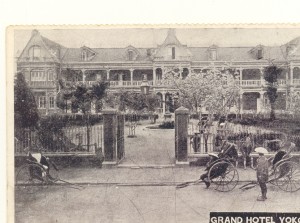
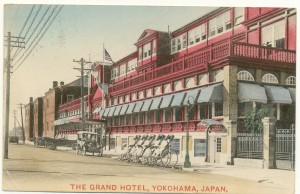
Posted: June 6th, 2014 | No Comments »
Yokohama’s history as a treaty port is often overlooked and a little forgotten – Eric Han’s new history restores some of that….

Rise of a Japanese Chinatown is the first English-language monograph on the history of a Chinese immigrant community in Japan. It focuses on the transformations of that population in the Japanese port city of Yokohama from the Sino–Japanese War of 1894–1895 to the normalization of Sino–Japanese ties in 1972 and beyond. Eric C. Han narrates the paradoxical story of how, during periods of war and peace, Chinese immigrants found an enduring place within a monoethnic state.
This study makes a significant contribution to scholarship on the construction of Chinese and Japanese identities and on Chinese migration and settlement. Using local newspapers, Chinese and Japanese government records, memoirs, and conversations with Yokohama residents, it retells the familiar story of Chinese nation building in the context of Sino-Japanese relations. But it builds on existing works by directing attention as well to non-elite Yokohama Chinese, those who sheltered revolutionary activists and served as an audience for their nationalist messages. Han also highlights contradictions between national and local identifications of these Chinese, who self-identified as Yokohama-ites (hamakko) without claiming Japaneseness or denying their Chineseness. Their historical role in Yokohama’s richly diverse cosmopolitan past can offer insight into a future, more inclusive Japan.
Posted: June 4th, 2014 | No Comments »
Calling all Beijingers – if you’re not aware of, or are not a member of the Royal Asiatic Society Beijing it’s time to get along – they’re having a one year anniversary event this June 8th….
Dear Friends of RASBJ – Â Â Â Â Â Â Â Â Â Â Â Â Â Â Â Â Â Â Â Â Â Â Â Â Â Â Â Â 
Thanks to your support​, RASChina Beijing Chapter (RASBJ) has enjoyed a successful first year of informal operation and is now  formalizing  its structure and status.
​Accordingly, you are warmly invited to attend a combined celebration and Extraordinary General Meeting on Sunday June 8th, 3-5pm at Matthew Hu’s Courtyard Institute, Zhonglao Hutong #28, just east of Jingshan Park.  Please find attached an invitation with the Agenda and a map.
​Please come to learn more about RASBJ, tell us what you want from RASBJ, hopefully become a Member—and enjoy some refreshments in good company.
​There will be no elections or voting at this EGM, but at our first formal AGM in November, ​Members will have the opportunity, rare in China, to stand for formal and open Election by other Members, according to The Constitution.
​Kindly RSVP by May 31 to: membership@rasbj.org, so that we can cater for you!
Posted: June 4th, 2014 | 1 Comment »
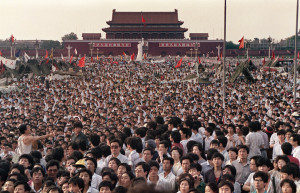
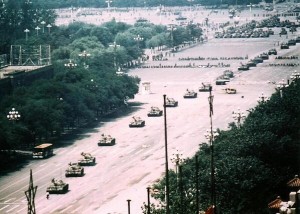

Posted: June 3rd, 2014 | No Comments »
An interesting collection of documents and essays on the Yellow Peril from ancient time to today….
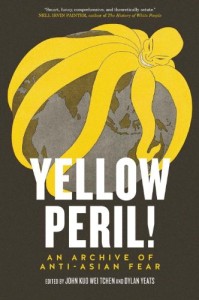
Yellow Peril!: An Archive of Anti-Asian Fear
“Smart, funny, and comprehensive.†– Nell Irvin Painter
The “yellow peril†is one of the oldest and most pervasive racist ideas in Western culture—dating back to the birth of European colonialism during the Enlightenment. Yet while Fu Manchu looks almost quaint today, the prejudices that gave him life persist in modern culture. Yellow Peril! is the first comprehensive repository of anti-Asian images and writing, and it surveys the extent of this iniquitous form of paranoia.
Written by two dedicated scholars and replete with paintings, photographs, and images drawn from pulp novels, posters, comics, theatrical productions, movies, propagandistic and pseudo-scholarly literature, and a varied world of pop culture ephemera, this is both a unique and fascinating archive and a modern analysis of this crucial historical formation.


















